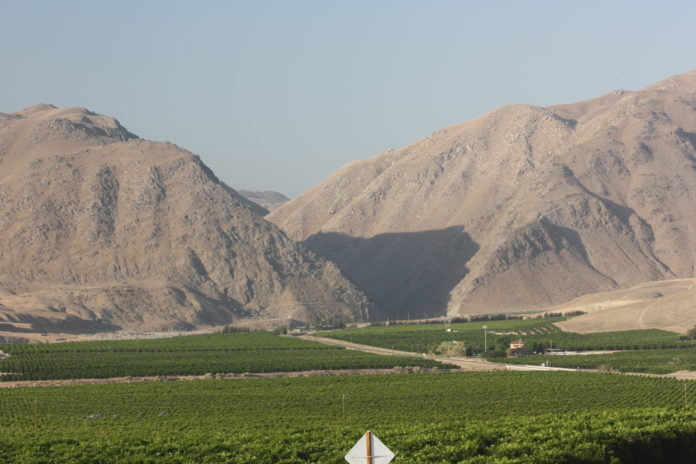 PPIC’s Ellen Hanak welcomed us into her dining room at 11:00am and began with a description of PPIC and what SGMA is. She explained how the Groundwater Sustainability Plans will be used as the roadmap to SGMA compliance. She did say there were 750 people registered to view this presentation. California Secretary of Agriculture Katherine Ross was welcomed as was Department of Water Resources Chief Karla Nemeth. Hanak also thanked the Bechtel Foundation for its financial support.
PPIC’s Ellen Hanak welcomed us into her dining room at 11:00am and began with a description of PPIC and what SGMA is. She explained how the Groundwater Sustainability Plans will be used as the roadmap to SGMA compliance. She did say there were 750 people registered to view this presentation. California Secretary of Agriculture Katherine Ross was welcomed as was Department of Water Resources Chief Karla Nemeth. Hanak also thanked the Bechtel Foundation for its financial support.
The program will take a look at the GSPs, then the Take Away and questions and answers. Hanak introduced Jelena Jezdimirovic who was instrumental in compiling the information.
Jezdimirovic said there are more than 100 GSAs in the Valley over the sub basins. She said she’s taking an archaeological attempt to glue all these things together. She used slides and the first one showed how much money, jobs and land would be lost if the only mitigation was to halt pumping. It also showed the impacts from better management options. The outlook was still somewhat pessimistic even including Valley-wide transfers and new water supplies.
She said the 13 plans made a very tall stack of paper. So the topic has been narrowed to just three criteria. She stated the variable time frames used for developing the GSPs have caused some discordance but not enough to find reasonable accuracy in the projected outcomes. She said most of the plans overestimated who much overdraft was taking place.
The next side showed all cropland, perennial and annual crops access to surface water. She correctly stated the perennial crops are the most valuable and have been a  boost to the Valley’s GDP. She also correctly pointed out the perennial crops are also the most vulnerable as they have to have annual water supplies to remain a viable investment. Flood water will be the most desirable and obtainable source for more recharge but PPIC believes the amount available was over estimated. Trading, recycling and water treatment were all considered; as was fallowing, pumping restriction and urban conservation. Jezdimirovic said PPIC doesn’t believe there won’t be as much water yield from these sources as the GSPs state.
boost to the Valley’s GDP. She also correctly pointed out the perennial crops are also the most vulnerable as they have to have annual water supplies to remain a viable investment. Flood water will be the most desirable and obtainable source for more recharge but PPIC believes the amount available was over estimated. Trading, recycling and water treatment were all considered; as was fallowing, pumping restriction and urban conservation. Jezdimirovic said PPIC doesn’t believe there won’t be as much water yield from these sources as the GSPs state.
Jezdimirovic showed the six deadly sins of SGMA and said the PPIC review only focused on subsidence and long term water level depletions. She said the plans don’t have enough protections for domestic wells, particularly in the Kings Sub Basin. Some of the plans to the north and the very south of the Valley have domestic well thresholds and mitigation programs. Some of the plans have no plan for domestic wells.
Subsidence has also been a challenge in the Valley. It has hit the Friant Kern Canal and the California Aqueduct and other infrastructure. There are hot spots and some of the plans are willing to accept a good deal of subsidence. She had praise for the Chowchilla and Mendota Sub Basins for setting subsidence goals.
Jezdimirovic said putting together the GSPs has been a great achievement but there is more that needs to be done. Hanak said there was a great deal of work to create what has been accomplished so far. She said today’s presentation was meant to point out weak areas to work on. She said it is important to remember these plans were not made to fix everything right away. There is a five year update coming soon. Budget considerations are also going to cut back SGMA implementation funds. She hopes the state remembers how important supporting successful SGMA will be.
In Hanak’s opinion the GSPs are too local to achieve much. Regional infrastructure will be needed. She wants to see the state incentivize going beyond local and to plan regional responses to undesirable results. She said Madera and Chowchilla are looking to address domestic wells issues, it may be cheaper to drill them new wells.
She said finding out what works and modeling that for others will be very valuable and important. The state and federal agencies need to support pilot programs. She said recharging flood waters needs to be made a greater priority. She suggested an auction for flood water.
Q&A
Geoff Vandenheuvel made a statement saying it should be no surprise demand management isn’t the first action in a 20-year plan.
Hanak said that makes sense but the plans to reduce need to get on a ready position now. I other words to get ready to fallow land. She also said groundwater trading is being show as promising in Kern County.
Dave Orth asked something but I didn’t catch it.
Jezdimirovic said regional coordination is very important. The opportunity to add up the numbers will be very important to the review process.
Orth also asked if there are any GSPs not addressing undesirable results and Jezdimirovic said the results of the PPIC review are online.
Lois Henry asked how much budget cuts will impact SGMA.
Hanak said she hopes the state won’t cut back the review process.
Jezdimirovic said many of the plans are counting on the same buckets of water. Storage is needed to capture more surface water but she doesn’t thing the investment in the required infrastructure won’t pay for itself.
Hanak addressed irrigation improvements saying it isn’t a pass to increase acreage. You have to reduce crop water usage and you do that by taking land out of production. She said how to do this with the least amount of harm to the economy is the question. She said moving surface water around and going on a groundwater diet can be  effective. How to make the traders whole and the communities ok will require thinking more about what land comes out of production. Fallowing must also provide alternative value to the land and not just be a dust storm. This will take the regional look.
effective. How to make the traders whole and the communities ok will require thinking more about what land comes out of production. Fallowing must also provide alternative value to the land and not just be a dust storm. This will take the regional look.
Hanak also said in addition to folks in the Valley refining their plans there needs to be more state involvement. Someone asked who should pay for the drinking water impacts DACs may experience. Jezdimirovic said she said a partnership with the state, the local and the regional economy. Hanak added while GSAs have the power to impose fees that is easier said than done. She said thinking creatively about that may require pooling funding from state and federal programs along with the local funding. Jezdimirovic said more information sharing between water banks would be useful.
Hanak said DWR needs to play a bigger role in helping coordinate more regional solutions. She pointed to the San Joaquin Valley Water Blueprint is a good example of this big picture look at the what helps. And with that the hour was up. Those PPIC gals are punctual.
DISCLAIMER OF RESPONSIBILITY; Waterwrights.net strives to provide his clients with the most complete, up-to-date, and accurate information available. Nevertheless,  Waterwrights.net does not serve as a guarantor of the accuracy or completeness of the information provided, and specifically disclaims any and all responsibility for information that is not accurate, up-to-date, or complete. Waterwrights.net’s clients therefore rely on the accuracy, completeness and timeliness of information from Waterwrights.net entirely at their own risk. The opinions expressed in this report are those of the author and do not represent any advertisers or third parties.
Waterwrights.net does not serve as a guarantor of the accuracy or completeness of the information provided, and specifically disclaims any and all responsibility for information that is not accurate, up-to-date, or complete. Waterwrights.net’s clients therefore rely on the accuracy, completeness and timeliness of information from Waterwrights.net entirely at their own risk. The opinions expressed in this report are those of the author and do not represent any advertisers or third parties.
ALL RIGHTS RESERVED. Copyright 2020 by Don A. Wright































